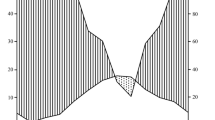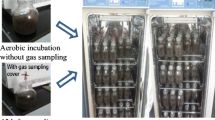Abstract
The effects of select monoterpenes on nitrogen (N) mineralization and nitrification potentials were determined in four separate laboratory bioassays. The effect of increasing monoterpene addition was an initial reduction in NO3 −-N production (nitrification inhibition), followed by a reduction in the sum of NH4 +-N and NO3 −-N (inhibition of net N mineralization and net immobilization at high monoterpene additions. Monoterpenes could produce this pattern by inhibiting nitrification, reducing net N mineralization, enhancing immobilization of NO3 −-N relative to NH4 +-N, and/or stimulating overall net immobilization of N by carbon-rich material.
Initial monoterpene concentrations in the assay soils were about 5% of the added amount and were below detection after incubation in most samples.
Potential N mineralization-immobilization, nitrification, and soil monoterpene concentrations were determined by soil horizon for four collections from a ponderosa pine (Pinus ponderosa) stand in New Mexico. Concentrations of monoterpenes declined exponentially with soil depth and varied greatly within a horizon. Monoterpene content of the forest floor was not correlated with forest floor biomass. Net N mineralization was inversely correlated with total monoterpene content of all sampled horizons. Nitrification was greatest in the mineral soil, intermediate in the F-H horizon, and never occurred in the L horizon. Nitrification in the mineral soil was inversely correlated with the amount of monoterpenes in the L horizon that contain terminal unsaturated carbon-carbon bonds (r 2 = 0.37, P ⩽ 0.01). This pattern in the field corresponded to the pattern shown in the laboratory assays with increasing monoterpene additions.
Similar content being viewed by others
References
Bremner JM & McCarty GW (1988) Effects of terpenoids on nitrification in soil. Soil Science Society of America Journal 52: 1630–1633
Carlyle JC & Malcolm DC (1986) Nitrogen availability beneath pure spruce and mixed larch + spruce stands growing on a deep peat. I. Net nitrogen mineralization measured by field and laboratory incubations. Plant and Soil 93: 95–113
Dev S. (Ed), (1982) Handbook of Terpenoids-monoterpenoids. Volumes I and II. CRC Press, Boca Raton, Florida, USA
Gosz JR & White CS 1986 Seasonal and annual variation in nitrogen mineralization and nitrification along an elevational gradient in New Mexico. Biogeochemistry 2: 281–297
Horner JD, Gosz JR & Cates RG (1988) The role of carbon-based plant secondary metabolites in decomposition in terrestrial ecosystems. American Naturalist 132: 869–883
Johnson WR (1988) Soil survey of Socorro County area, New Mexico. USDA, Soil Conservation Service. U.S. Government Printing Office, Washington, D.C.
Keeney DR (1980) Prediction of soil nitrogen availability in forest ecosystems: a literature review. Forest Science 26: 159–171
Mabry TJ & Gill JE (1979) Sesquiterpene lactones and other terpenoids. In: Rosenthal GA & Janzen DH (Eds) Herbivores. Their Interaction with Secondary Plant Metabolites (pp 501–537). Academic Press, New York
Massaldi HA & King CJ (1973) Simple technique to determine solubilities of sparingly soluble organics: Solubility and activity coefficients of d-limonene, n-butylbenzene, and n-hexyl acetate in water and sucrose solutions. Journal of Chemical and Engineering Data 18: 393–397
McCarty GW & Bremner JM (1986) Inhibition of nitrification in soil by acetylenic compounds. Soil Science Society of America Journal 50: 1198–1201
Nadelhoffer KJ, Aber JD & Melillo JM (1983) Leaf litter production and soil organic matter dynamics along a nutrient availability gradient in southern Wisconsin (USA). Canadian Journal of Forest Research 13: 12–21
Nadelhoffer KJ, Aber JD & Melillo JM (1984) Seasonal patterns of ammonium and nitrate uptake in nine temperate forest ecosystems. Plant and Soil 80: 321–335
Prosser JI (1986) Nitrification. Special Publication of the Society for General Microbiology, Vol 20. IRL Press, Washington D.C
Rice CW & Tiedje JM (1989) Regulation of nitrate assimilation by ammonium in soils and in isolated soil microorganisms. Soil Biology & Biochemistry 21: 597–602
Schmidt E (1982) Nitrification in soil. Agronomy Monographs 22: 243–288
Smith RH (1977) Monoterpenes of ponderosa pine xylem resin in Western United States. USDA Technical Bulletin No. 1532, 48 p
Smyrl TG & LeMaguer M (1980) Solubilities of terpenic essential oil components in aqueous solutions. Journal of Chemical Engineering Data 25: 150–152
Swift MJ, Heal OW & Anderson JM (1979) Decomposition in Terrestrial Ecosystems. Studies in Ecology, Vol 5. University of California Press, Los Angeles
White CS (1986a) Effects of prescribed fire on rates of decomposition and nitrogen mineralization in a ponderosa pine ecosystem. Biology and Fertility of Soils 2: 87–95
White CS (1986b) Volatile and water-soluble inhibitors of nitrogen mineralization and nitrification in a ponderosa pine ecosystem. Biology and Fertility of Soils 2: 97–104
White CS (1988) Nitrification inhibition by monoterpenoids: theoretical mode of action based on molecular structures. Ecology 69: 1631–1633
White CS (1990) Comments on “Effects of Terpenoids on Nitrification in Soil.” Soil Science Society of America Journal 54: 296–297
White CS & Gosz JR (1987) Factors controlling nitrogen mineralization and nitrification in forest ecosystems in New Mexico. Biology and Fertility of Soils 5: 195–202
White CS, Gosz JR, Horner JD & Moore DI (1988) Seasonal, annual, and treatment-induced variation in available nitrogen pools and nitrogen-cycling processes in soils of two Douglas-fir stands. Biology and Fertility of Soils 6: 93–99
White CS & McDonnell MJ (1988) Nitrogen cycling processes and soil characteristics in an urban versus rural forest. Biogeochemistry 5: 243–262
Wilt FM, Miller GC & Everett RL (1988) Monoterpene concentrations in litter and soil of singleleaf pinyon woodlands of the Western Great Basin. Great Basin Naturalist 48: 228–231
Author information
Authors and Affiliations
Rights and permissions
About this article
Cite this article
White, C.S. The role of monoterpenes in soil nitrogen cycling processes in ponderosa pine. Biogeochemistry 12, 43–68 (1991). https://doi.org/10.1007/BF00002625
Received:
Accepted:
Issue Date:
DOI: https://doi.org/10.1007/BF00002625




